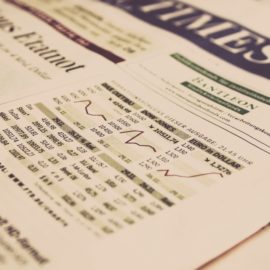

This article is an excerpt from the Shortform summary of "The Smartest Guys in the Room" by Bethany McLean and Peter Elkind. Shortform has the world's best summaries of books you should be reading.
Like this article? Sign up for a free trial here .
What was the Enron mark to market accounting method that lead to the company’s downfall? Why did they use these schemes?
The Enron mark to market accounting method may not have been illegal, but were certainly unethical. Enron mark to market accounting mislead investors and allowed Enron to continue operating on a budget that didn’t exist. Find out what Enron accounting practices contributed to Enron’s collapse.
Enron and Mark to Market Accounting
What was Enron mark to market accounting, and why did it fail? Enron used mark-to-market accounting for its deals, which allowed booking the total value of a deal immediately, rather than spaced out over time. They practiced this throughout the business, including on private equity and venture capital investments.
Mark-to-market requires assumptions about the future performance of deals, and naturally they skewed optimistic. These assumptions were not visible to the public.
Accounting practices that disguised the fundamentals
The root of Enron has to be the Enron accounting method that enabled deception. They let Enron book more revenue than they actually earned; keep losses and debt off balance sheets. If these were disallowed, the money-losing state of Enron would have been apparent far sooner.
- Mark-to-market accounting was an Enron accounting method that allowed booking the total value of a deal immediately, rather than spaced out over time.
- Complicated SPE deals allowed Enron to borrow money while keeping it off their balance sheet
- One-time asset sales were booked as recurring revenue
- Deals that were actually dead were fictitiously kept alive to avoid a writedown that quarter
All this structure became so convoluted that no one totaled up the big picture. No one pieced together the dependencies between Enron’s deals, and how the dominoes would fall if Enron’s stock price fell.
According to the author, the Enron accounting practices were meant to be short-term bridges to the real new money-makers: Enron Energy Services (retail utilities) and Enron Broadband.
Stock Prices Rise Despite Enron’s Mark to Market Accounting
Despite all this trouble bubbling under the surface, in the heady period of 1999-2000, Enron stock exploded in price, reaching ~90 in Aug 1999 before being split 2:1, then doubling to reach 90 again in Aug 2000 for a market cap of $70 billion. It outperformed the S&P by over 200%.
This is a testament to how powerfully the Enron accounting method distortions disguised the true nature of the problems brewing.
- 2000 revenues showed $100 billion, 100% over 1999. Earnings hit $1.3 billion, up 25% per share.
Enron was paraded as a visionary company, building new businesses like Enron Online in the Internet era, despite Enron’s mark to market accounting.
The Beginning of the End
Unsurprisingly due to Enron’s accounting method, The SPE Raptor deals ran into trouble.
- The Raptor deals became underwater by 9 figures, especially in the market hit after September 11.
- Andersen auditors realized they made an accounting error – Raptor restructuring had been booked as a boost in shareholder equity and needed to be reversed, costing equity $1.2 billion.
- This would be recorded as a simple equity reduction, rather than a restatement, which would admit mistakes and trigger SEC inquiries and lawsuits.
- COO Whalley argued to take the hit and clean up. They felt Enron would recover after cleaning up.
- To make the accounting look more favorable, Enron wanted the correction as a nonrecurring charge. Since this was originally booked as operating profit, this was grossly inappropriate. Andersen put up a fight, but ultimately Enron forced their hand.
On Oct 16 2001, Enron shared its third quarter report. They were sanguine as usual: “recurring Q3 earnings of $.03 per diluted share; reports nonrecurring charges of $1.01 billion…reaffirms recurring estimates.”
On Oct 24, 2001, Enron mark to market accounting was unable to roll its “commercial paper,” short-term loans used for day-to-day expenses. It had no operating cash.
- It desperately tried to make deals for cash – like opening up its books – but no one was willing to bite. It had to draw down $3 billion in backup credit lines.
- The last-ditch solution was to sell their pipelines, the only steady cash generator Enron had left.
- Enron’s trading also required credit to survive – trading partners would start demanding cash collateral.
Through this turmoil, Arthur Andersen began realizing how bad their work with Enron would make them look.
- Andersen had previously paid fines for accounting fraud at Waste Management – it had a cease-and-desist from the SEC from misconduct. In that case, Andersen’s records had provided regulators with plenty of proof – it wanted to avoid that mistake again.
- There was a shredding frenzy in both Enron and Arthur Andersen (following normal “document retention procedures”) until an official subpoena on Oct 26 forced them to stop.
- Andersen also saw major mistakes in Enron’s SPEs accounting, with the 3% not being truly independent capital. This meant the deals had to go back on Enron’s books.
Once dancing to Enron’s tune, the bankers realized their new leverage over Enron and took advantage.
- Beyond its credit line, Enron needed an extra $2 billion in cash. Banks refused to let it borrow the loans unsecured like before – now it demanded the only collateral remaining – the pipeline systems – and exclusive business with Enron for the next 18 months.
In early November, a possible savior came in a possible merger with smaller energy company Dynegy.
Meanwhile, the SEC required that Enron disclose the Fastow partnerships and restate its earnings on Thursday November 8.
- Also, all three ratings agencies cut Enron to one notch above junk by Nov 5. Shares went below $10.
- On Wednesday, the stock dropped 25% on news that Enron was unable to line up $2 billion from private investors.
On Friday, Enron announced the merger with Dynegy. Shares rose 16% to $10.
On Tuesday, November 13, $2 billion arrived for Enron. They took a breath, but it wasn’t enough.
- Enron realized it was going to need to repay more than $9 billion by the end of 2002. It would need a lot more money.
- Enron’s trading partners continued demanding collateral. The number of transactions plummeted, and trading profits crashed.
- An SPE (Rawhide) was structured to unwind if its debt had been downgraded to one step above junk. It now had to repay $690 million in debt.
- In six days, Enron had burned through a billion dollars. Its stock fell to below $5.
On Dynegy’s side, the lack of transparent disclosure of possible problems and Ken Lay’s insistence on maintaining control of Enron crashed the deal. The banks weren’t coming up with more money that Enron needed.
On Wednesday November 28, the rating agencies cut Enron into junk territory.
- This triggered $3.9 billion in debt.
- Dynegy officially canceled the deal.
- Enron Online shut down. Shares dropped to $0.61
Banks moved to minimize their losses, asking for return of collateral. Enron didn’t have it.
On Sunday, December 2, Enron filed for bankruptcy. The Enron mark to market accounting strategy had failed.
You might be surprised to learn that most of Enron’s accounting practices were not technically illegal at the time – they were actually publicly celebrated for being financial innovations. Shareholders, employees, investment bankers, and accountants all benefited from the situation and enabled Enron for years. They only stopped when it became untenable.
The Enron mark to market accounting method were not unique to Enron, but the company exploited and benefitted from these laws (or lack thereof). Enron accounting allowed a culture of deceit to continue, and directly contributed to the company’s collapse.

———End of Preview———
Like what you just read? Read the rest of the world's best summary of Bethany McLean and Peter Elkind's "The Smartest Guys in the Room" at Shortform .
Here's what you'll find in our full The Smartest Guys in the Room summary :
- How Enron rose to become one of the world's most promising companies
- How Enron management's greed led it to start cutting corners
- The critical failures that crashed Enron's house of cards to the ground






